When Nav and I were discussing what to do for our final project, we thought about what we love the most about games, and about what kind of experience we wanted to recreate. One specific experience came up in both of our memories; playing a game, then going on the internet looking for cheat codes, noting them down on a piece of paper and rushing back to the console to try them out, whether they were codes to get a helicopter in Grand Theft Auto or more money in the Sims. With that in mind, we set out to make a game with a core disruptive mechanic: cheating.

The title screen.
Trial is a 3D platformer where the protagonist has to pass two levels in order to prove that they’re worthy and be able to claim a mythical treasure. The first level is a cave maze-like environment which Nav designed, and the second one is a sky level where the player has to hop between falling and moving clouds, which I designed. To travel between the levels, the player has to get through the environment until they reach a rock which makes them teleport to the next part. At the end of the game, the player is in front of a closed room, and a message appears which tells the player to use a secret code to open the doors of the room and claim the treasure to win the game, for they are worthy. However, it does not always go that way… If the player takes a moment mid-game to look around them, they will see that the computer is on a desk littered with toys, kitsch decorations, and most importantly, a book that says on the cover “DO NOT OPEN”. If the player does open the book regardless, they will find a list of cheat codes to input in the game. The codes can either customize how the player character looks, or change the game mechanics, making the game easier to win, or breaks the physics to an unplayable level (for example, using reverseGravity in the cloud level ends with an endless jump into the sky). And if the player does decide to use these codes, they will be presented with a different ending; the game knows that the challenger has been cheating, and thus, they are not worthy. “Try without cheating next time,” says the message as the screen fades to black and the game fades to black.

Simple messages explain the game’s story.
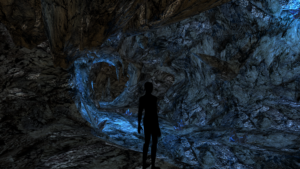
The cave maze, where the player is presented with different paths.
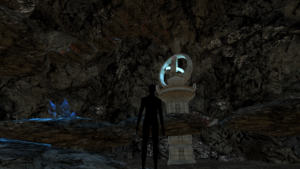
Jumping up the stone platforms lead into a teleporter to the next level.
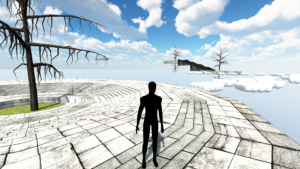
In the Sky Trial, the player has to get past falling cloud platforms and moving platforms. The challenge proved however to be too hard for most players.
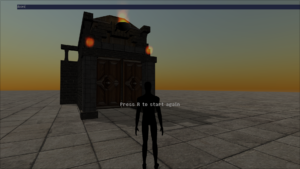
Using the code doors in the last part of the game lets the player access the treasure – if they haven’t cheated too many times.
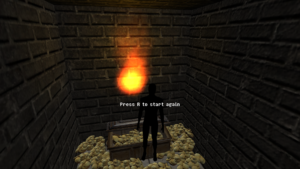
The treasure.
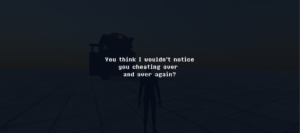
Another kind of ending.
To implement the game, we used background prefabs (rocks, trees, crystals, treasure at the end, etc.) from the Ultimate Fantasy Creator asset, which gave to the game a very nice semi-realistic dungeon atmosphere. The character is taken from 3rd Person Controller + Fly Mode. We chose this faceless because it did the job (walking, flying, jumping) and was simple enough esthetic and mechanics-wise so that it was easy to customize it when using the codes. The cloud platforms were taken from the website Models Ressource ripped from the game Super Mario Galaxy 2. As for the sounds, the music on the title screen was taken from Zelda II The Adventure of Link. The music in the first two levels was taken from The Legend of Zelda: Breath of the Wild, as well as the bell sounds that come with every message. Finally, the music at the end (finding the treasure) was taken from The Legend of Zelda: Majora’s Mask. Obviously, The Legend of Zelda games had a big influence on our game as we wanted to go with a similar mood. Besides the assets, nostalgia influenced the rest of our implementation process as well; the messages that appear at the beginning, as well as the title screen text, are meant to look like 8-bit text from old GameBoy games, and the cheat code text box is reminiscent of the one that appears at the top of the screen in The Sims.
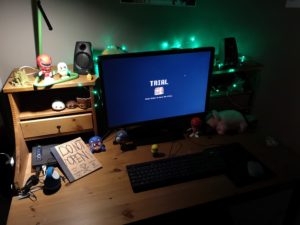
Our setup.

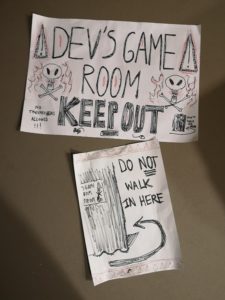
“Inviting” signs outside the curtain.
As for the coding part, we wrote scripts for transitioning and/or teleporting between the levels, respawning if the character falls in the void, and of course, taking the code inputs after Ctrl+C has been pressed. Here’s a list of the possible codes and their effects:
-bigBoy: makes the character bigger.
-smallBoy: makes the character smaller.
-amyRose: changes the character texture to pink.
-squirtle: same as above but blue.
-reverseGravity: reverse gravity.
-superMario64: gives the player the ability to fly.
-sonicTheHedgehog: makes the character run faster.
-bigJump: increases the jump height.
-biggerJump: increases the jump height more.
-catInTheHat: gives the character an enormous hat.
-doors: opens the doors at the end of the game if the player has not cheated or only a few times.
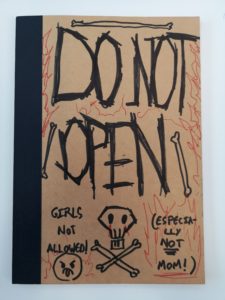
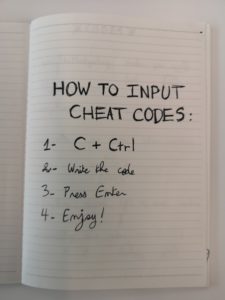

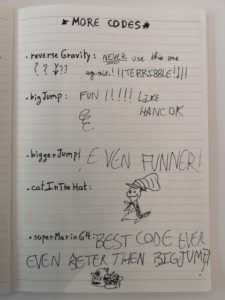
Each of the cheat codes has a sin value depending on how game-breaking it is, and using them adds up to a sinCounter variable, which determines whether the player gets to access the treasure or not. Most of the codes are also named after iconic video games or characters to go with the nostalgia theme.
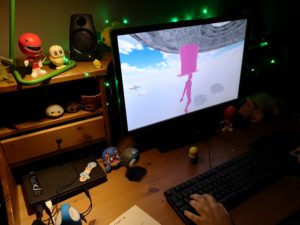
Someone playing Trial.
In my opinion, the playtesting sessions at the IM show were quite successful. While we wanted to make it possible for the game to be won without cheating (save for the doors code), we intentionally made it hard and even frustrating at times to push the players to think outside the box and not miss out on the cheating mechanics, which were the core of the game, and increased their fun and made them laugh, which is what we intended the game for. One thing however that didn’t work as much as we wish it had was finding out about the code. While we thought that the book was pretty obviously part of the game and meant to be open, a lot of the players seemed to ignore it even if they were stuck in the game until we suggested to them to look around them and think outside of the box (but trying our best not to be obvious). This may be due to the decoration of the desk, which may have been so well done that the book would stand out less from the rest and look just like another prop. Using a smaller desk lamp that only shone on the book might also have helped. As for the game themselves, we discovered during the tests a few little bugs that we couldn’t fix; for example, the player has to press enter a couple of times in the title screen to be able to play rather than only once. I also realized that the cloud level was even harder than I intended to be, and no one actually managed to complete it – although some people might have stuck around for the challenge if we had more time. Finally, the game’s controls were a bit confusing for players who weren’t very game-savvy (especially controlling the camera and moving at the same time) so we probably should have added a couple more instructions. But overall, all of the players reported to have fun using the cheat codes and were fascinated by the game’s aesthetics. Most of them also commented on how cozy or cute they found the setup, which is what we were going for.
I believe that Trial succeeds in expressing disruption. A hidden child’s room in the middle of the IM show is disruptive, and many were surprised to find us behind the curtain – even though that also meant that we got fewer people than expected, but the game was long enough so that we always had someone playing. Once the players found out about the codes, their playstyle changed completely and their fascination with the backgrounds turned to sheer fun as they enthusiastically tried each one of them. And while it may bum them out a little that they were not, after all, worthy, they all found the concept cool regardless, and were even more curious about the other ending possibilities.